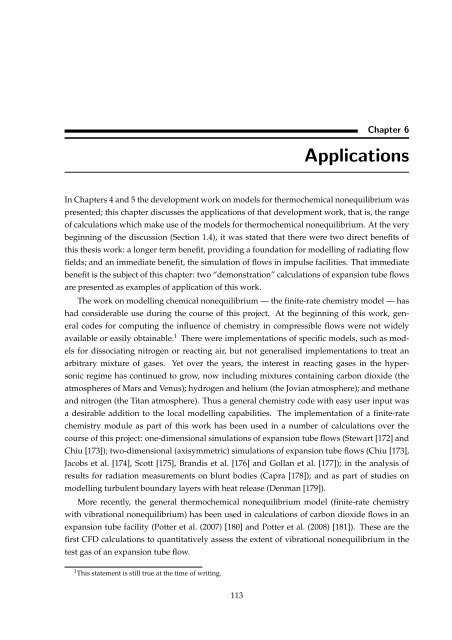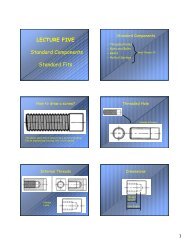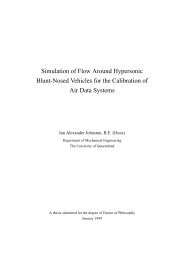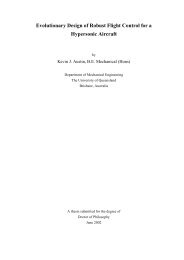Rowan-Gollan-PhD-Thesis - Mechanical Engineering - University of ...
Rowan-Gollan-PhD-Thesis - Mechanical Engineering - University of ...
Rowan-Gollan-PhD-Thesis - Mechanical Engineering - University of ...
You also want an ePaper? Increase the reach of your titles
YUMPU automatically turns print PDFs into web optimized ePapers that Google loves.
Chapter 6<br />
Applications<br />
In Chapters 4 and 5 the development work on models for thermochemical nonequilibrium was<br />
presented; this chapter discusses the applications <strong>of</strong> that development work, that is, the range<br />
<strong>of</strong> calculations which make use <strong>of</strong> the models for thermochemical nonequilibrium. At the very<br />
beginning <strong>of</strong> the discussion (Section 1.4), it was stated that there were two direct benefits <strong>of</strong><br />
this thesis work: a longer term benefit, providing a foundation for modelling <strong>of</strong> radiating flow<br />
fields; and an immediate benefit, the simulation <strong>of</strong> flows in impulse facilities. That immediate<br />
benefit is the subject <strong>of</strong> this chapter: two “demonstration” calculations <strong>of</strong> expansion tube flows<br />
are presented as examples <strong>of</strong> application <strong>of</strong> this work.<br />
The work on modelling chemical nonequilibrium — the finite-rate chemistry model — has<br />
had considerable use during the course <strong>of</strong> this project. At the beginning <strong>of</strong> this work, gen-<br />
eral codes for computing the influence <strong>of</strong> chemistry in compressible flows were not widely<br />
available or easily obtainable. 1 There were implementations <strong>of</strong> specific models, such as mod-<br />
els for dissociating nitrogen or reacting air, but not generalised implementations to treat an<br />
arbitrary mixture <strong>of</strong> gases. Yet over the years, the interest in reacting gases in the hyper-<br />
sonic regime has continued to grow, now including mixtures containing carbon dioxide (the<br />
atmospheres <strong>of</strong> Mars and Venus); hydrogen and helium (the Jovian atmosphere); and methane<br />
and nitrogen (the Titan atmosphere). Thus a general chemistry code with easy user input was<br />
a desirable addition to the local modelling capabilities. The implementation <strong>of</strong> a finite-rate<br />
chemistry module as part <strong>of</strong> this work has been used in a number <strong>of</strong> calculations over the<br />
course <strong>of</strong> this project: one-dimensional simulations <strong>of</strong> expansion tube flows (Stewart [172] and<br />
Chiu [173]); two-dimensional (axisymmetric) simulations <strong>of</strong> expansion tube flows (Chiu [173],<br />
Jacobs et al. [174], Scott [175], Brandis et al. [176] and <strong>Gollan</strong> et al. [177]); in the analysis <strong>of</strong><br />
results for radiation measurements on blunt bodies (Capra [178]); and as part <strong>of</strong> studies on<br />
modelling turbulent boundary layers with heat release (Denman [179]).<br />
More recently, the general thermochemical nonequilibrium model (finite-rate chemistry<br />
with vibrational nonequilibrium) has been used in calculations <strong>of</strong> carbon dioxide flows in an<br />
expansion tube facility (Potter et al. (2007) [180] and Potter et al. (2008) [181]). These are the<br />
first CFD calculations to quantitatively assess the extent <strong>of</strong> vibrational nonequilibrium in the<br />
test gas <strong>of</strong> an expansion tube flow.<br />
1 This statement is still true at the time <strong>of</strong> writing.<br />
113







